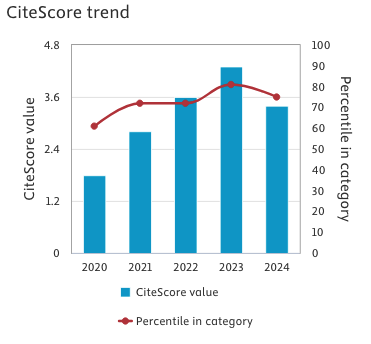Unraveling inflammation’s role in cerebral aneurysm recanalization: A comprehensive systematic review
Keywords:
cerebral aneurysm, coiling, recanalization, inflammation, cytokines , macrophageAbstract
Background: Although significant progress has been made in identifying risk factors for cerebral aneurysms (CAs), the exact pathological mechanisms responsible for aneurysm recurrence remain poorly elucidated. Inflammation has increasingly been implicated in the progression and recurrence of aneurysms following endovascular coiling. This systematic review aims to evaluate the role of inflammatory factors in post-coiling recanalization across intracranial aneurysms based on literature from the last decade.
Methods: The review was conducted in accordance with PRISMA 2020 guidelines. English-language studies published between 2015 and 2025 were retrieved using PubMed, SpringerLink, SagePub, and Google Scholar. Editorials, review articles, duplicate publications, and studies lacking a digital object identifier (DOI) were excluded. Articles were screened through a three-step process (title, abstract, and full-text review).
Results: A total of 1,800 records were identified through database searches. After applying inclusion and exclusion criteria and conducting full-text analysis, seven eligible studies were included. The selected literature reported on inflammatory mediators such as tumor necrosis factor-α (TNF-α), interleukin-1β (IL-1β), matrix metalloproteinase (MMP-2) and MMP-9, macrophage subtypes, and complement system activation. These factors were associated with impaired thrombus stabilization, delayed endothelial repair, and increased likelihood of CA recanalization.
Conclusion: Inflammatory responses are key contributors to aneurysm recurrence following coiling, acting through vessel wall degradation, extracellular matrix remodeling, and endothelial dysfunction. Macrophage infiltration, cytokine upregulation, MMP activation, and complement involvement are mechanistically linked to long-term instability of treated aneurysms. Future research should explore anti-inflammatory adjunct therapies, optimize biomaterial selection, and identify predictive inflammatory biomarkers to enhance the durability of endovascular aneurysm treatment. (www.actabiomedica.it)
References
1. Amuluru K, Al‑Mufti F. Cerebral aneurysms: Formation, growth, and rupture. In: Al‑Mufti MF, Amuluru K, editors. Cerebrovascular Disorders. Springer US; 2021. p. 3–15. doi:10.1007/978‑1‑0716‑1530‑0
2. Chung DY, Abdalkader M, Nguyen TN. Aneurysmal subarachnoid hemorrhage. Neurol Clin. 2021;39:419‑42. doi:10.1016/j.ncl.2021.02.006
3. de Vos LC, Boersema J, Hillebrands JL, et al. Diverging effects of diabetes mellitus in patients with peripheral artery disease and abdominal aortic aneurysm. BMJ Open. 2017;7:e012584. doi:10.1136/bmjopen-2016-012584
4. Etminan N, Chang HS, Hackenberg K, et al. Worldwide incidence of aneurysmal subarachnoid hemorrhage. JAMA Neurol. 2019;76:588‑97. doi:10.1001/jamaneurol.2018.4784
5. Fang Y, Lu J, Zheng J, Wu H, et al. Comparison of aneurysmal subarachnoid hemorrhage grading scores. Sci Rep. 2020;10:9199. doi:10.1038/s41598-020-66160-0
6. Galea JP, Dulhanty L, Patel HC, UK and Ireland Subarachnoid Hemorrhage Database Collaborators. Predictors of outcome in aneurysmal subarachnoid hemorrhage patients. Stroke. 2017;48:2958‑63. doi:10.1161/STROKEAHA.117.018217
7. Jeon JP, Cho YD, Yoo DH, et al. Risk factor analysis of recanalization timing. AJNR Am J Neuroradiol. 2017;38:1765‑70. doi:10.3174/ajnr.A5236
8. Grüter BE, Canzanella G, Hägler J, et al. Topographic distribution of inflammation factors. J Neuroinflammation. 2023;20:182. doi:10.1186/s12974-023-02841-5
9. Wang J, Wei L, Lu H, Zhu Y. Roles of inflammation in intracranial saccular aneurysms. J Neurol Sci. 2021;424:117294. doi:10.1016/j.jns.2021.117294
10. Lattanzi S, Norata D, Divani AA, et al. Systemic inflammatory response index and futile recanalization. Brain Sci. 2021;11:1164. doi:10.3390/brainsci11101164
11. Jin J, Duan J, Du L, Xing W, Peng X, Zhao Q. Inflammation and immune cell abnormalities in intracranial aneurysm subarachnoid hemorrhage (SAH): Relevant signaling pathways and therapeutic strategies. Front Immunol. 2022;13:1027756. doi:10.3389/fimmu.2022.1027756
12. Roa JA, Sarkar D, Zanaty M, et al. Immune response after aneurysmal subarachnoid hemorrhage. Sci Rep. 2020;10:11809. doi:10.1038/s41598-020-68862-2
13. Khashim Z, Daying D, Hong DY, et al. M1 and M2 macrophages in aneurysm healing. AJNR Am J Neuroradiol. 2020;41:1657‑62. doi:10.3174/ajnr.A6674
14. Brinjikji W, Shahi V, Cloft HJ, Lanzino G, Kallmes DF, Kadirvel R. Statin use and recurrence rates following coiling. AJNR Am J Neuroradiol. 2015;36:2104‑7. doi:10.3174/ajnr.A4434
15. Wang X, Huang X. Risk factors of rupture in cerebral aneurysms. Front Physiol. 2024;15:1454016. doi:10.3389/fphys.2024.1454016
16. Sawyer DM, Pace LA, Pascale CL, et al. Lymphocytes influence intracranial aneurysm formation. J Neuroinflammation. 2016;13:185. doi:10.1186/s12974-016-0671-4
17. Turjman AS, Turjman F, Edelman ER. Fluid dynamics and inflammation in aneurysm formation. Circulation. 2014;129:373‑82. doi:10.1161/CIRCULATIONAHA.113.003149
18. Funakoshi Y, Imamura H, Tani S, Adachi H, Fukumitsu R, Sunohara T, et al. Predictors of cerebral aneurysm rupture after coiling. AJNR Am J Neuroradiol. 2020;41:828‑35. doi:10.3174/ajnr.A6455
19. Chen C, Tang F, Zhu M, et al. Role of inflammatory mediators in intracranial aneurysms: A review. Clin Neurol Neurosurg. 2024;242:108329. doi:10.1016/j.clineuro.2024.108329
20. Yokoi T, Saito M, Yoshimura Y, et al. Cerebral aneurysms and inflammation. Neuroimmunol Neuroinflammation. 2015;2:55‑8. doi:10.20517/nin.2014.15
21. Rabkin SW. Matrix metalloproteinases in aneurysm. Prog Mol Biol Transl Sci. 2017;147:239‑65. doi:10.1016/bs.pmbts.2017.02.009
22. Lei C, Yang D, Chen W, et al. Chemotaxis and complement system in aortic aneurysms. J Transl Med. 2021;19:49. doi:10.1186/s12967-020-02690-1
23. Morgan FC, Ruiz ES, Karia PS, Besaw RJ, Neel VA, Schmults CD. Predictors of recurrence and metastasis. J Am Acad Dermatol. 2020;83:832‑8. doi:10.1016/j.jaad.2020.05.071
24. Dodd WS, Laurent D, Dumont AS, et al. Delayed cerebral ischemia after SAH. J Am Heart Assoc. 2021;10:e021845. doi:10.1161/JAHA.120.021845
25. Starke RM, Chalouhi N, Jabbour PM, et al. TNF‑α in cerebral aneurysm formation. J Neuroinflammation. 2014;11:77. doi:10.1186/1742-2094-11-77
26. Bellapart J, Laupland KB, Malacova E, Roberts JA, Paratz J. Nimodipine prophylaxis in SAH. J Clin Neurosci. 2024;123:91‑9. doi:10.1016/j.jocn.2024.03.018
27. Chyatte D, Bruno G, Desai S, Todor DR. Inflammation and intracranial aneurysms. Neurosurgery. 1999;45:1137‑47. doi:10.1097/00006123-199912000-00001
28. Hong EP, Cho SM, Rhim JK, et al. Inflammation‑related genes and intracranial aneurysm. J Korean Neurosurg Soc. 2023;66:525‑35. doi:10.3340/jkns.2022.0201
Downloads
Published
Issue
Section
License
Copyright (c) 2025 Muhammad Yunus Amran, Siti Giranti Ardilia Gunadi, Yusran Ady Fitrah, Brigita Dian Pasereng, Evira Syahfitri

This work is licensed under a Creative Commons Attribution-NonCommercial 4.0 International License.
This is an Open Access article distributed under the terms of the Creative Commons Attribution License (https://creativecommons.org/licenses/by-nc/4.0) which permits unrestricted use, distribution, and reproduction in any medium, provided the original work is properly cited.
Transfer of Copyright and Permission to Reproduce Parts of Published Papers.
Authors retain the copyright for their published work. No formal permission will be required to reproduce parts (tables or illustrations) of published papers, provided the source is quoted appropriately and reproduction has no commercial intent. Reproductions with commercial intent will require written permission and payment of royalties.






